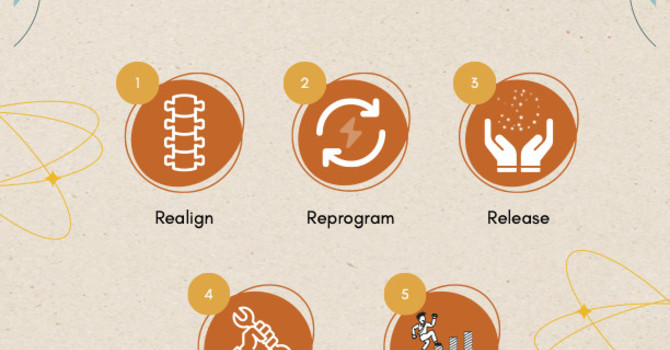
When explaining to my patients my approach to care, I use metaphors. I often begin with a house analogy.
THE HOUSE
You have probably heard the saying that the body is the temple of the soul, so picture your body as the house in which you live. If you have all the appliances and lights on at once and you blow a circuit, what is the first thing you do?
THE CIRCUIT BREAKER (the spine)
First, you go outside and reset the circuit breaker. The circuit breaker both resembles and functions much like the human spine. Nerve roots from each spinal level go to specific muscles and organs. Thus there is an organ/muscle relationship. If there is an overloaded circuit in your body, it will inevitably make itself known in your nervous system, resulting in a tripped circuit. Chiropractors refer to this as a Vertebral Subluxation. This is what chiropractors the world over work with. We find and correct subluxations of the spine through the chiropractic adjustment, thus resetting your body’s circuitry. When this balance is restored, the body can maintain proper balance and health. This process is referred to as homeostasis.
THE LIGHTS (the muscles)
But what happens when you go back inside your “house” and turn on all your appliances and lights again? Likely you’ll once again overload the system and trip a circuit. So in addition to going back out and resetting the circuit breaker (ie getting adjusted again), what’s the next step?
If you blew out some bulbs or tripped an internal fuse of an appliance then those will need replacing. I liken this analogy to Myofascial work. That is, releasing tight spasmed muscles which may be compensating for other under-firing muscles.
THE SWITCHES (the receptors)
But what happens when there are some lights that when turned on cause other lights to flicker or blow out? The problem in the house is most often in the internal wiring, relays and switches.
I use a technique called P-DTR (Proprioceptive Deep Tendon Reflex technique) which so elegantly allows me to use muscle testing to find dysfunctional pain or positional receptors throughout the body. P-DTR was developed over the last 20 years by spinal surgeon and Orthopedist Jose Palomar. He came from a tradition of AK (Applied Kinesiology) and functional neurology. Dr Palomar found a way to (in my words) “hack” the nervous system by fully understanding the functions of each involved pathway and aspect of the proprioceptive nervous system.
THE ALARM SYSTEM
Think of proprioception as the alarm receptors on your windows that tell the alarm company (ie your brain) when a window has been opened. Proprioceptors throughout the body constantly relay information to the brain about everything from movement, position, stretch, vibration and types of pain such as pinpricks, slaps, crude & fine touch, hot, cold, itch, tickle and more!
Dysfunctional receptors are found in specific muscle pairs, but also in ligaments, tendons, on the skin, along cranial sutures, pretty much everywhere. Finding and correcting these dysfunctional signals to the brain (remember, information in = proprioception) brings the dysfunctional part of the body back to “factory presets” and won’t repeat itself again unless the body finds itself in another situation where that dysfunctional pattern is its only perceived way to navigate through a stressful situation.
EMOTION
Then there is the Mind-Body. In my experience the most common causes of dysfunction are physical, chemical and emotional. Over the past 50 years huge strides have been made in the scientific understanding of how emotions affect the body. Dr. Candice Pert, a senior NIH scientist in the 80s, discovered the Opiate Receptor and found that these receptors were everywhere throughout the fascia in the body. She termed these complex polypeptides Molecules of Emotions (the title of her famous book) and concluded that we literally store emotion not just in our brain but throughout our bodies.
TECHNIQUES (my bag of tools)
Working on a house (the body) requires many tools to address each area of possible dysfunction. Below are my specific set of tools for each area:
BONES & JOINTS
There are hundreds of techniques and as many ways to make an adjustment.
NECK
For the Cervical Spine (neck) and lumbar spine (low back) I like to use a system called Kinese-Release Methods or Quick-Release Methods developed by my mentor, colleague and friend Dr Ethan Feldman. Dr Feldman took Jones’ Osteopathic system of Strain Counter-Strain and adapted it beautifully to the spine in a very accessible way for chiropractors.For the mid-back I like to use traditional manual adjustments.
THORACIC SPINE
In the thoracic region the ribs support the spine. This region is very stable and safe to adjust in this manner.
PELVIS
The pelvic joints are large and rugged and take a lot of force to adjust, so my preferred approach is three-fold:
Drop table is a movable piece under the pelvis that drops maybe an inch to the chiropractor’s hands. The faster the piece moves, the less force I use, thus I don’t need to use much force to make a correction.
SOT Blocks (Sacro Occipital Technique) are actually they’re wedges. When placed under the pelvis in various configurations they create a fulcrum that works with time and the patient’s weight to make the adjustment.
Hesch Method is a physical therapy approach that I recently added that entails very detailed palpation of all the joints of the pelvis and all the ways they should move but may be stuck. In this system, I simply hold the stuck component into correction for several minutes, either with my hand or with a foam roll.
MUSCLES & FASCIA
For soft tissue, I use many techniques.
ART (Active Release Technique) which is a very precise “art” and took a lot of specific and detailed training to isolate, pin and stretch affected muscles.
IASTM (Instrument assisted soft tissue manipulation) which uses surgical metal tools to “scrape” the fascia. I have studied a system called FAKTR (Function and kinetics in treatment & rehab) which uses these same tools but utilizes various stages of movement, proprioception (balance) and resistance to more effectively release tight and dysfunctional fascial chains (To better understand Fascial Chains, think of a sheet of Saran Wrap connecting a swath of muscles all working together).
Myofascial Decompression aka Cupping, is a system that has been used for probably millenia. It is best recognized from Chinese Medicine systems but has also been used as a folk medicine in most cultures. Cupping is the only true decompressive technique out there. I studied it as Myofascial Decompression at UCSF. It is a very effective way to release stuck fascial patterns.
Kinesiology Tape effectively reinforces this release work by providing a low but constant decompressive force to the skin, fascia, muscle region being addressed. I use Rocktape, a name brand I prefer (like Jell-O is to Gelatin).
MIND-BODY
I have studied multiple techniques to address the effects of stress physiology and my favorite is NET (Neuroemotional Technique).
NEUROEMOTIONAL TECHNIQUE (NET) is a multi-disciplinary technqiue that effectively in shifts/changes dysfunctional emotional memories literally stuck in the tissues as well as in parts of the brain.
BRAIN-STEM: The amygdala (aka lizard brain) is where we form initial survival “programs”, usually as young children.
MID-BRAIN: The mid-brain is called the mammalian brain and is what typically runs the show. It is where most of our emotionally-based decisions come from, including how we ultimately make buying decisions!
CEREBRAL CORTEX: The outer brain, aka the “new brain” or Neo Cortex is our rational brain. It likes to think it is in control but it really isn’t. When any of these three brains is out of congruence with any of the other two, the nervous system essentially goes into “tilt” much like how a washing machine will turn off if out of balance or a pinball machine would turn off if literally tilted.
NET has been around since the mid 80s and I discovered it in the early 2000s. As an aside, there are several things I love about the NET organization. Over the past 15+ years I’ve been associated with it, it has grown from an insular group of eclectic chiropractors and acupuncturists and now includes Nurse Practitioners, Naturopaths, holistic MDs, and therapists from counselors to psychiatrists. It is supported by its very own research organization based at Thomas Jefferson University Medical School where they’ve published over 30 major studies in peer reviewed journals over the past 15 years.
PAIN
When a patient first comes into my practice it is usually because they are in acute or chronic pain. Pain is the ultimate motivator - either mental or physical - and is the operative word here.
FIRE
Picture pain as a fire. If a house is on fire, my job first and foremost is to extinguish the fire, not to worry about its cause - at least not yet. Putting out the fire means directly addressing the fire itself. Clinically that usually entails chiropractic adjustments and tissue-release techniques as described above.
BACK TO THE HOUSE
So what is the cause of this fire/pain? It may be something very physical, such as a car accident or a sports injury, from which we sometimes need to rule out broken bones or torn muscles via Xray or MRI. But in most cases this is not the case.
COMPENSATION
Often even sudden pain (ie low back pain) may come as a result of the “last straw” syndrome - ie there was enough dysfunction and compensation in the body that it just took that last thing, be it bending down to tie your shoe (structural) or having that difficult conversation with your elderly parent (emotional).
POSTURE & MOVEMENT
Structural dysfunction can also be a result of chronically poor posture or movement patterns (such as hinging, squatting, pulling, pushing) or even incorrect ergonomics (think of the Covid years on a laptop at your kitchen table).
DIET
I also mentioned chemistry earlier and won’t get into that in this article, nonetheless in both AK, P-DTR and NET chemistry is a component that can be addressed as well.So there you have it. I put out the fire and then figured out what caused it in the first place.
PUTTING IT ALL TOGETHER
Traditional chiropractic can be very powerful, but in my eyes it stops short of addressing all the players involved. One thing I love about most of the techniques I’ve studied and incorporated into my practice over the past 25 years is that they are truly interdisciplinary. All of the Myofascial systems I have studied had chiropractors, physical therapists, massage therapists and even personal trainers as students. This holds true as well for P-DTR. And NET is open to any licensed health professional.
I strongly believe that the more we step out of our respective fields, the more open our minds become and this cross-disciplinary mindset ultimately benefits the patient the most. Which is why (I hope) we are all here learning all of this stuff in the first place! Some of my best patient outcomes come from people who came to me after trying surgical interventions, physical therapy, chiropractic or personal training (one note about this last one - if you have dysfunction in your body and you throw yourself into hard workouts to overcome it, you unfortunately will end up with more dysfunction as your body compensates the hell out of itself to keep you safe throughout the exercises). Usually by the time this patient comes to me, they’re open to what I have to offer. I have on occasion seen decades of pain resolve in just a handful of treatments. Though that is always my hope it is never my promise.
If this article intrigues you even a little bit and if you are in pain and looking for some answers, I encourage you to give us a call and see if I can help you.






